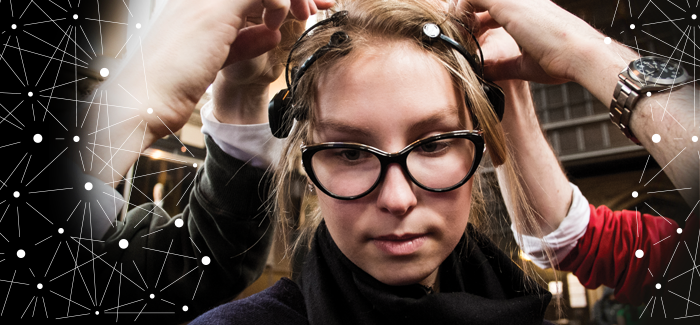
The Think Tank partnered with NEURO to engage students in experiments for Brain Awareness Week in March. (Photography by Tom Tian, AB’10)
The Think Tank dispatches neuroscience from the lab to the neighborhood.
Last year, when psychology professor Daniel Casasanto was a faculty member at the New School, one of his research assistants came to him with a quirky idea: a Brainmobile.
The Brainmobile—a mobile neuroscience lab with a giant glowing brain on its roof—could be used not only to publicize new research in neuroscience, Tyler Alterman suggested, but also to study different populations. Casasanto’s research centers on how experience shapes the brain and mind, so studying people with diverse life experiences is important.
Casasanto was skeptical. The project would require a lot of time and money, and he wasn’t sure the populations would be all that different: “The truck wouldn’t let us go to Namibia,” he says. And why use a truck to publicize science when PBS does such a good job?
With Casasanto’s qualified support, Alterman set up a web page for the project—renamed the Think Tank at his mother’s suggestion—on the crowd-funding site Indiegogo. In just a few months, Alterman had reached his fundraising goal of $10,000.
The project was now possible, but Casasanto still wasn’t convinced of its mission. Then he visited UChicago on a faculty recruitment trip. “I learned about all the ways the University is working to increase diversity in the sciences,” he says.
For example, psychology professors John and Stephanie Cacioppo, along with Hakizumwami Birali Runesha, director of the Research Computing Center, had recently founded the High Performance Brain Academy, which brings Chicago Public Schools students to campus to study neuroimaging. Suddenly Casasanto saw a clear purpose for the mobile neurolab: “I realized the Think Tank could be, so to speak, a vehicle for change.”
After Casasanto and Alterman arrived at UChicago last fall, they developed three programs for the Think Tank: Street Science, School Science, and Think Tank Fellows.
Street Science, which involves sidewalk talks and live demonstrations from the back of the truck, debuted at the American Association for the Advancement of Science meeting in February. One demonstration uses the Robo-Roach, a tiny backpack that connects to a live roach; participants can control the roach’s movements using their smartphones.
School Science, a five-week curriculum developed in conjunction with the undergraduate club NEURO, takes neuroscience to the University of Chicago Charter School Woodlawn Campus. “Science is usually taught as a catalog of facts,” says Casasanto. “As a working scientist, I can tell you that is not how science works at all.” (Casasanto and Alterman both “hated” science in high school; Casasanto spent a decade as an opera singer, and Alterman studied graphic design in college, before each discovered neuroscience.) “You could even say there are no facts in science. It’s not about finding the right answers but about becoming progressively less wrong.”
The Think Tank’s inquiry-focused curriculum is aligned with new science standards adopted by Illinois in 2011. “For science teachers who’ve been teaching a certain way for 20 years, it’s going to be a struggle to adapt,” Alterman says. “So School Science is intended to serve as a model.”
The Think Tank Fellows will come out of the School Science program at the Woodlawn high school. “A small handful of students who have the right stuff,” says Casasanto, will be invited to join the program, which will bring rising juniors into psychology and neuroscience labs for two summers. The students will be mentored one-on-one by graduate students and postdocs in the Department of Psychology, and they will be paid: “One of the practices that contributes to the exclusivity of higher education is the unpaid internship,” says Casasanto. “We want to make sure that money is no object.” The fellows program will pilot this summer; Casasanto and Alterman hope to raise funds for a full-fledged program next year.
In March the Think Tank had more fundraising success: in collaboration with NEURO it won a $9,000 award from the College’s Uncommon Fund to pay for the Illuminoggin, the glowing fiberglass brain atop the truck. “The hope is that someone would be able to control it with their own brain—to activate certain parts of your brain and have the giant brain light up,” says Alterman. “We’re still not sure that’s possible.”
